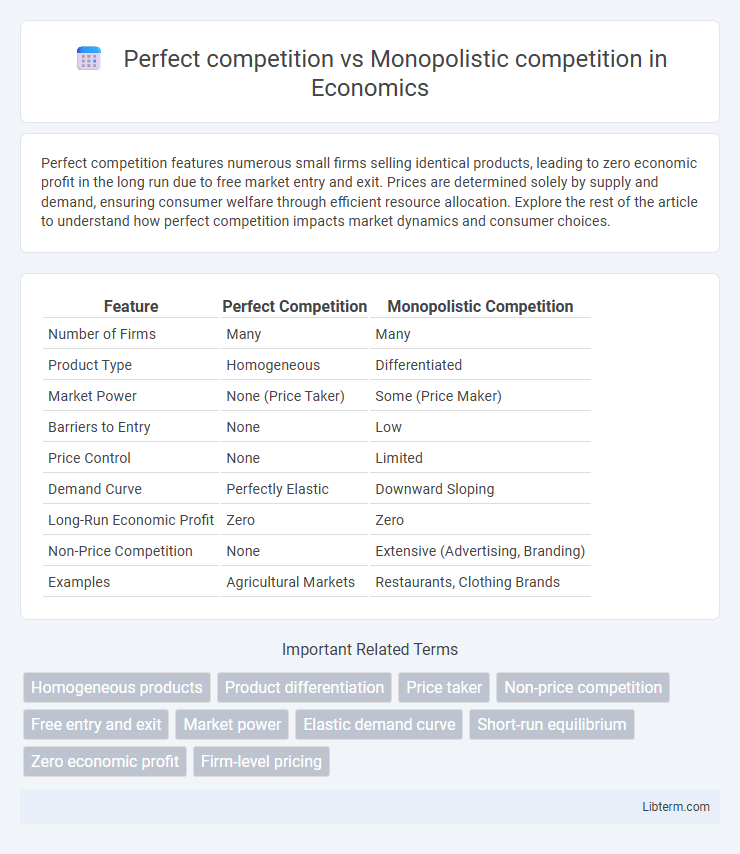Perfect competition features numerous small firms selling identical products, leading to zero economic profit in the long run due to free market entry and exit. Prices are determined solely by supply and demand, ensuring consumer welfare through efficient resource allocation. Explore the rest of the article to understand how perfect competition impacts market dynamics and consumer choices.
Table of Comparison
| Feature | Perfect Competition | Monopolistic Competition |
|---|---|---|
| Number of Firms | Many | Many |
| Product Type | Homogeneous | Differentiated |
| Market Power | None (Price Taker) | Some (Price Maker) |
| Barriers to Entry | None | Low |
| Price Control | None | Limited |
| Demand Curve | Perfectly Elastic | Downward Sloping |
| Long-Run Economic Profit | Zero | Zero |
| Non-Price Competition | None | Extensive (Advertising, Branding) |
| Examples | Agricultural Markets | Restaurants, Clothing Brands |
Introduction to Market Structures
Perfect competition features numerous small firms selling identical products, leading to a highly efficient market with no single company controlling prices. Monopolistic competition consists of many firms offering differentiated products, allowing for some degree of price-setting power and non-price competition such as advertising. Both market structures help explain pricing strategies, market entry barriers, and consumer choice dynamics within different competitive environments.
Defining Perfect Competition
Perfect competition is an economic market structure characterized by a large number of small firms, homogeneous products, and free entry and exit, ensuring firms are price takers with no market power. In perfect competition, all participants have perfect information, leading to allocative and productive efficiency in the long run. This contrasts with monopolistic competition, where product differentiation and some degree of market power allow firms to influence prices.
Characteristics of Monopolistic Competition
Monopolistic competition is characterized by a large number of firms offering differentiated products, allowing for some degree of market power and price-setting ability. Firms face relatively elastic demand curves due to the availability of close substitutes, leading to non-price competition through advertising and product differentiation. Unlike perfect competition, monopolistic competition exhibits free entry and exit, which results in normal profits in the long run.
Key Differences Between the Two Markets
Perfect competition features numerous small firms selling identical products with no single buyer or seller able to influence market price, resulting in firms being price takers. Monopolistic competition involves many firms offering differentiated products, giving each some control over pricing due to brand loyalty and product uniqueness. Entry and exit are easy in both markets, but product differentiation and non-price competition are key characteristics distinguishing monopolistic competition from the homogeneous offerings of perfect competition.
Pricing Mechanisms and Market Power
Perfect competition features firms as price takers with no market power, where prices are determined by the intersection of industry-wide supply and demand, leading to allocative efficiency. In monopolistic competition, firms possess some market power due to product differentiation, allowing them to set prices above marginal cost while still facing downward-sloping demand curves. Pricing mechanisms in monopolistic competition result in less price uniformity and productive inefficiency compared to perfect competition, reflecting the trade-off between variety and pricing control.
Product Differentiation and Consumer Choice
Perfect competition features homogenous products with no differentiation, leading consumers to base choices primarily on price. Monopolistic competition offers differentiated products, allowing firms to influence consumer preferences through unique features, branding, and quality variations. This product differentiation enhances consumer choice by providing varied options aligned with individual tastes and needs.
Barriers to Entry and Exit
Perfect competition features no significant barriers to entry or exit, allowing firms to freely enter or leave the market based on profit opportunities, ensuring market efficiency and zero economic profits in the long run. Monopolistic competition presents low but not negligible barriers to entry and exit, such as brand loyalty and product differentiation, which can limit new entrants and afford existing firms some degree of market power and short-term economic profits. The presence or absence of these barriers critically influences market dynamics, firm behavior, and the degree of competition in each market structure.
Efficiency and Welfare Outcomes
Perfect competition achieves allocative and productive efficiency by ensuring resources are optimally distributed and firms produce at minimum average cost, maximizing consumer and producer surplus. Monopolistic competition results in inefficiencies due to product differentiation and market power, leading to higher prices and excess capacity, which reduce overall social welfare. Welfare outcomes in perfect competition are superior as consumer surplus is maximized, while monopolistic competition generates some consumer choice benefits but at the cost of deadweight loss.
Real-World Examples and Applications
Perfect competition is exemplified by agricultural markets where numerous farmers sell homogeneous products like wheat, creating a highly competitive environment with minimal price control. Monopolistic competition appears in the retail clothing industry, where brands differentiate products through style and quality, allowing some pricing power despite many competitors. Real-world applications highlight perfect competition's efficiency in commodity markets, while monopolistic competition drives innovation and variety in consumer goods.
Conclusion: Implications for Businesses and Consumers
Perfect competition drives businesses to operate efficiently and offer products at the lowest possible prices, benefiting consumers with maximum choice and minimal cost. Monopolistic competition encourages product differentiation and innovation, allowing firms to target specific consumer preferences but often leading to higher prices and less efficiency. Businesses must weigh the trade-offs between cost leadership and brand differentiation, while consumers experience varying degrees of price sensitivity and product variety depending on the market structure.
Perfect competition Infographic

 libterm.com
libterm.com